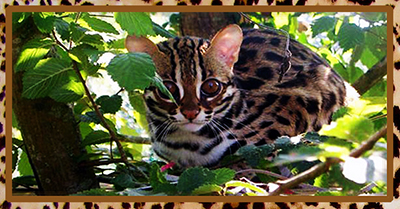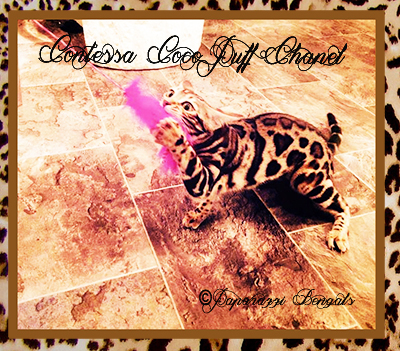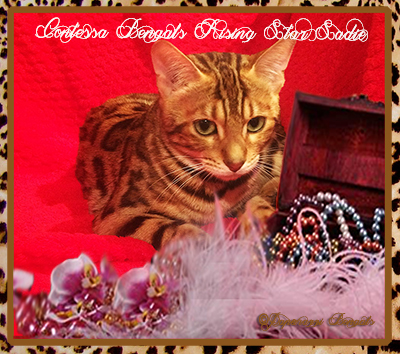FUN FACTS ABOUT BENGALS
The Asian Leopard Cat is a shy and timid creature, and relatively small – not very “wild” when you compare them to their big cat cousins!
Trademark Traits
Bengals have a clear “M” on the forehead.
Beautiful leopard-print coat
Agile and athletic
Very vocal
Highly intelligent
Demanding
Loves water

Wild Ancestry
The Bengal cat dates only from the early 1960s, when a breeder crossed a domestic feline with an Asian leopard cat. The breed is named for this wild Asian cat, whose scientific name is Prionailurus bengalensis.
Water
Forget the myth that kitties don't like to get wet. The Bengal is an exception - many Bengals enjoy playing in water. Be careful if you keep an aquarium as your fish may have some unwelcome company. You might have a companion in the tub,
Bengals love to take showers and baths
Glitter Gene
In addition to the beautiful marbling or spotted rosette features of the Bengals' coat, some cats inherit the so-called "glitter gene," which gives their coats an iridescent quality.
Climbing
Bengals love to climb. Perhaps there's a mountain-climbing gene in there along with the glitter. If you have high cupboards or very tall furniture, you may find your Bengal has gone where no cat has ever gone before.
Just Like A Dog
Bengals have several attributes found more often in canines than felines. He likes to play fetch, and if you want to take your indoor Bengal outside try walking him on a leash.

Bengals can learn dog-like tricks
With a little bit of patience, positive reinforcement techniques and some treats, Bengals can be taught simple dog-like tricks such as rolling over, sitting up or jumping through hoops.

Cat Burglar
If you come home and some of your jewelry is missing, it might have been an inside job. Stash anything glittery away from your Bengal (maybe another version of the glitter gene?) as he loves to play with and hide such objects. They like shiny objects and may steal them and hide it.
Tricks
Your Bengal enjoys learning tricks. Keep this smart cat entertained and out of mischief by teaching him tricks, like jumping or retrieving. You also should provide him with plenty of cat toys, but not ordinary ones like stuffed mice. Give him something he must figure out, like kitty puzzles.
http://pets.thenest.com/fun-bengal-cats-5777.html
Quick Facts
Weight: 10 - 15 pounds
Height: about 16 inches
Ideal Human Companions
Busy, active families
Experienced cat owners
Households with other pets, including dogs
Bengals take up to two years to reach maturity.
Bengals are ideal candidates for clicker training. ( So what is cat clicker training? Cat clicker training is an easy and fun way to help shape your cat's behavior. The click is something that he can uniquely associate with the desired behavior. The treat then immediately follows the click, reinforcing the positive consequences of the behavior. http://www.catster.com/cat-behavior/clicker-training-for-cats )
CAT FACTS
A cat's sense of smell is 14 times stronger than a humans!
Besides their noses, cats can smell with something called the "Jacobson's organ", located in the upper surface of their mouths.
This is what cats are using when they scrunch up their eyes and open their mouths after sniffing something intently!
Cats have 244 bones in their bodies! (About 40 more than humans!)
Cats have 32 muscles in each ear!
Cats only sweat from the pads of their paws; ever notice how wet the examination room table gets when you take your cat to the vet?
Cats aren't hunters by nature; their mothers teach them to hunt!
Female cats can reach adulthood in as little as five months, but male cats can take nine months to a year to reach adulthood. Most breeds of cats have reached their full growth by two years!
 Cats are said to see color. Studies have been able to prove that cats can distinguish between red and green; red and blue; red and gray; green and blue; green and gray; blue and gray; yellow and blue, and yellow and gray! Cats are said to see color. Studies have been able to prove that cats can distinguish between red and green; red and blue; red and gray; green and blue; green and gray; blue and gray; yellow and blue, and yellow and gray!
The bottom two rows of whiskers on a cat can move independently of the top two rows!
Whiskers tell a cat whether the space they are entering is big enough for it!
The oldest cat on record was a female tabby that lived to be 34 years old!
Cats have about 100 different vocalization sounds. In comparison, dogs have about 10!
The largest litter of kittens on record is 19!!!
Cats can purr to express pain or fear in addition to expressing pleasure. Female cats often purr when they are in labor, as well as when they are nursing their kittens!
http://www.hdw-inc.com/felinefun2.htm
http://www.catster.com/cat-breeds/Bengal
***The Asian Leopard Cat is an accomplished swimmer. Therefore the Bengal tends to be infatuated with water!***
Bengal Cats tend to have an extensive vocabulary. In addition to a cat's meow, my Bengals use a variety of chirps, peeps, and bleats, as well as the usual growls and hisses. In fact Bengals have 100 sounds compared to dogs only 10. |